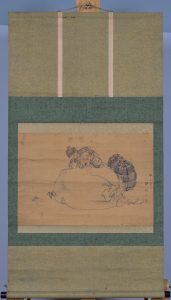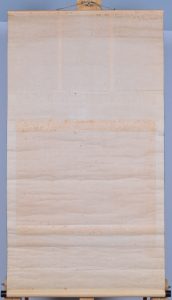Scrolling in the Deep: Treating Asian Artworks in a Western Context
by Mhairi Boyle
Part One: Beginnings – Before Treatment
When I went to Japan last year, I decided to pick up a Japanese hanging scroll both as a learning object and as an initial gateway into the world of Asian art conservation. The scroll, currently titled Daikokuten, was bought at Teramachi-dori, the antiques hub of Kyoto, (Figures 1 & 2). Daikokuten was selected because it had signs of wear and tear common to this kind of object, especially since it was mounted in the traditional Japanese system, which comes with its own set of complex inherent vices.
Introduced to Japan from China in the sixth century, this mounting system gives the artwork more durability and flexibility. Hanging scrolls and other forms of Japanese artwork such as folding screens were assembled in keeping with the seasons and fashions of when they were created, and it was expected that they would be appropriately changed when styles shift (Burdett & Thomson 2002, p. 32; Nishio 2001, p. 16).
Figures 1 & 2: Before Treatment photographs of ‘Daikokuten’ (Japanese Hanging Scroll)
It is this rolling and unrolling of hanging scrolls that results from constant display or remounting that protects as well as damages them. The Daikokuten scroll is no exception. It, ironically, also suffers from too much storage, as shown by extensive creases and cracks in both the mounting system and painting (Figure 3). These are especially apparent in raking light (Nishio 2001, p. 16) (Figure 4). In a museum or gallery environment, it is recommended that the hanging scrolls on display are changed at least every six months to ensure their long-term preservation to prevent this (Hare 2006, p. 74).


There is also a tear on the bottom roller of the scroll, which is often unavoidable given that the scroll is not only an artwork, but a functional object. Part of its purpose and lifetime is to be rolled and unrolled on a semi-regular basis (Figure 5). Similarly, the tear on the top stave of the scroll is a result of it being displayed; the weight of the object puts a strain on the paper support (Nishio 2001, p. 21). These problems are exacerbated with improper storage, handling, and display, and part of this treatment was learning the appropriate methods to ensure the objects’ long-term preservation.

But what shape should long-term conservation take? An issue faced in Western institutions is the question of how far a treatment can be taken. In Japan, it is common for the painting element of a hanging scroll to be remounted and the old mount discarded. This is performed by master scroll-mounters who have been in training for at least a decade. The process itself can also take a very long time, sometimes years (Burdett & Thomson 2002, p. 32; Uyeda 2011, p. 109). When designing a treatment pathway, this was taken into consideration. Treatment of this object was an exercise in adaptability. How is this kind of object treated in a Western context using different tools and methods? What minor treatment can be undertaken in a tight timeframe? These considerations moulded a treatment pathway that took advantage of traditional, more restoration-based Japanese methods, and combined them into a Western context which favoured minimally invasive treatment (Uyeda 2011, p. 102).
Part Two – Inherent Vice: Making Nice
In conservation, inherent vice is defined as a mechanism of deterioration that is an inherent, or internal, characteristic of an object (Johnson 1999, p. 7). There are three types of inherent vice:
- Short-lived materials, such as acidic wood-pulp paper
- Structural nature, such as loosely-adhered elements of an object
- History, such as dirt accumulation on an object designed for frequent handling (Johnson 1999, pp. 7-8).
In terms of Japanese hanging scrolls, the semi-frequent handling, rolling and unrolling of the scroll is an inherent vice related to both its structural nature and history. As previously mentioned, this manifests in the form of tears, creases, and cracks (Figures 1 & 2). Although scrolls withstand the test of time partly due to the restorative Japanese approach of remounting, there are other minor treatments that can be carried out which are less invasive and time-consuming.
A technique developed in East Asian conservation studios is the act of applying reinforcement strips to the verso of creased and cracked objects. If the crease is moistened and a moist strip is placed in the centre, they have the same drying rate and tenting will occur, straightening out the crease (Nishio 2001, p. 17). Traditionally, this would be carried out after completely removing the back linings of the scroll, which would then be re-lined after treatment (Catcher, Chang & Qinggui 2017, p. 50; Nishio 2001, p. 17). An even less invasive way would be to only remove parts of the lining which are creased, place the reinforcement strip, and then cover the area with another strip of lining paper (Nishio 2001, pp. 17-18) (Figure 6).
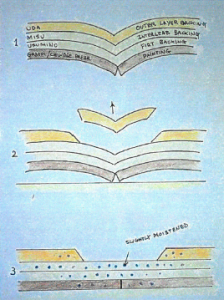
Because this treatment had time constraints, an even more minimally invasive approach was adopted. The final backing layer was kept intact, and strips were placed on top of this. Before commencing treatment, cracks and creases were identified using a transmitted and raking light (Sugiyama et al. 2014, p. 48) (Figure 4).

The next step was selecting appropriate paper for the strips. A heavy-weight kozo paper similar in colour was chosen, and cut into 3-4mm strips. This was used to repair the tear on the top stave (Figure 8).

In Japan, these strips have a straight edge, because feathered-edge strips tend to hold too much paste and moisture, causing a discrepancy in drying rates between the object and the strips (Nishio 2001, p. 18). Due to the strips being placed on top of the final lining, a lighter-weight feather-cut kozo paper was used over this to increase tensile strength. This paper was closer in colour to the object, and the edges were blotted to decrease moisture before being placed. It was then burnished down with a bone folder and a smoothing brush (Figures 6 & 7).

These treatment steps were an exercise in developing a traditional conservation method and making it more suitable for the nature of the treatment. The decision-making process had to consider the ethics of a minimally invasive treatment, the extent of the hand skills and experience required to perform a lining removal, and time constraints.

Part Three – What’s in the Box?! Rehousing and Reflections
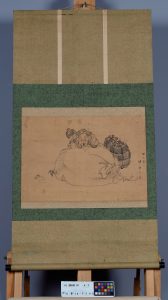

After object treatment was complete (see Figures 11 & 12), it was time to consider rehousing. Appropriate storage, handling, and display parameters are a vital part of enhancing the longevity of the life of a Japanese hanging scroll. Consisting of layers and layers of organic, fragile materials, scrolls are very susceptible to handling damage, airborne pollutants, and pests (Hare 2006, p. 73). The Daikokuten is no exception and was stained, dirty, mouldy, creased, and had evidence of previous insect damage during the purchase (Figure 13).
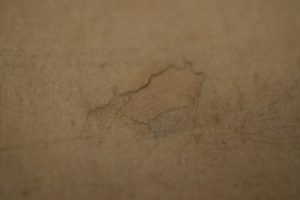
Archival-grade rehousing was an important step in reducing these agents of deterioration. There are a variety of housing options available. Traditionally, scrolls are housed in boxes made from paulownia wood, a white softwood favoured for its ability to swell in high humidity, creating a sealed microclimate in humid environments (Hare 2006, p. 78). For this treatment, an archival-grade board was used instead. Linen-lined foam cradles were inserted to cushion the scroll (Figure 14).

Another addition was the construction of a roller clamp. Roller clamps are designed to increase the diameter of the scroll when rolled, discouraging further creases and cracks to appear due to being rolled too tightly or narrowly (Nishio 2001, p. 18). Traditionally, these are made of paulownia wood. For this treatment, alternative materials were considered. The Freer and Sackler Galleries in Washington D.C. have developed two styles of roller clamps, constructed from thick polyester sheeting and a thick foam material. Due to the materials used not being available for this treatment, the decision was made to create a roller clamp made from archival-grade tube, thick kozo, and gummed linen tape. The clamp was made longer than the scroll itself, to prevent handling the object directly when unrolling it (Haruhiko et al. 2006, p. 22) (Figure 5).
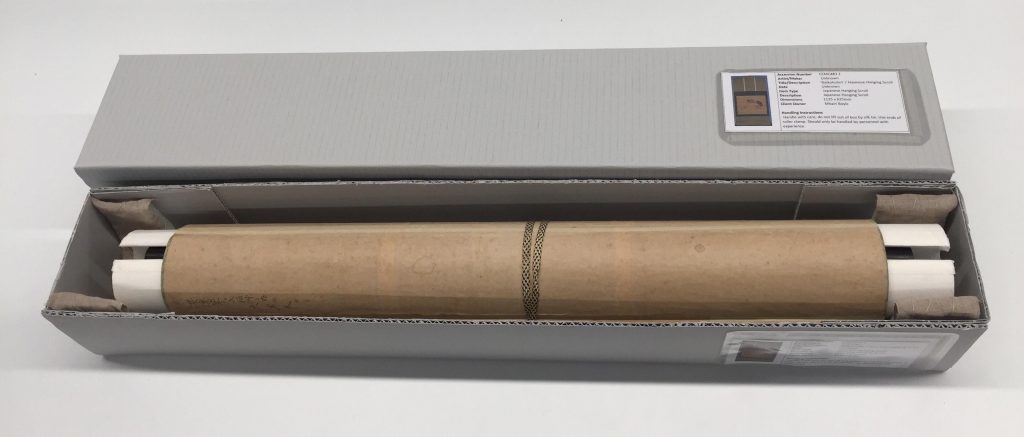
With this treatment came recommendations for the future. Eventually, it would be best for the scroll to undergo complete remounting. If provenance and attribution can be achieved through analysis of the artists’ seal, an appropriate mounting system can be selected based on the time-period and subject matter. A cotton muslin wrap is recommended to further protect the scroll from deterioration due to airborne pollutants, pests, and incorrect handling as it would discourage handling the scroll by its silk hanger (Hare 2006, p. 78).
Acknowledgements
I would like to thank my supervisor Libby Melzer for her valuable instruction and advice, and Marika Kocsis from the State Library of Victoria for her mentorship in the conservation of Japanese artworks on paper. I would also like to acknowledge my fellow paper conservation students for their encouragement and comradeship throughout the duration of my studies.
References
Burdett, S & Thomson, S 2002, ‘The Japanese Hanging Scroll: A Deconstruction’, Studies in Conservation vol. 47, no. 3, pp. 32-35.
Catcher, S, Chang, G & Zhu, Quinggui 2017, ‘The problem of Chinese paper reinforcement strip repairs on a set of four hanging calligraphic scrolls’, Journal of the Institute of Conservation, vol. 40, no. 1, pp. 49-63.
Hare, A 2006, ‘Guidelines for the care of East Asian Display, storage and handling’, The Paper Conservator vol. 30, no. 1, pp. 73-92.
Johnson, J 1999, ‘Chapter 4: Museum Collections Environment’, in National Parks Service Museum Handbook Part I: Museum Collections, National Parks Service, Washington, Washington DC, pp. 1-44.
Nishio, Y 2001, Maintenance of Asian Paintings II: Minor Treatment of Scroll Paintings’, The Book and Paper Group Annual, vol. 20, pp. 15-26.
Nishio, Y & Nishiumi, R 1985, ‘A Japanese Painting Strip Reinforcement Technique’, The Book and Paper Group Annual, vol. 4, pp. 1-4.
Sugiyama, K, Clark, T, Ambers, J & Verri, G 2014, ‘The study and conservation of the silk painting Death of the Buddha’, The British Museum Technical Research Bulletin, vol. 8, pp. 39-57.
Suzuki, H, Honta, S, Yonekura, Kamba, N, Tsuchiya, Y, & Matsuda, M 2009, ‘An Application of a New Roller Clamp for Scrolls: Towards an Approach to Symptomatic Treatment in Conservation’, Journal of the Japan Society for the Conservation of Cultural Property, vol. 54, pp. 52–65.
Uyeda, T 2011, ‘How far do we go? Compensation and Mounting Choices in the Treatment of Japanese Paintings’, The Book and Paper Group Annual, vol. 30, pp. 101-111.
